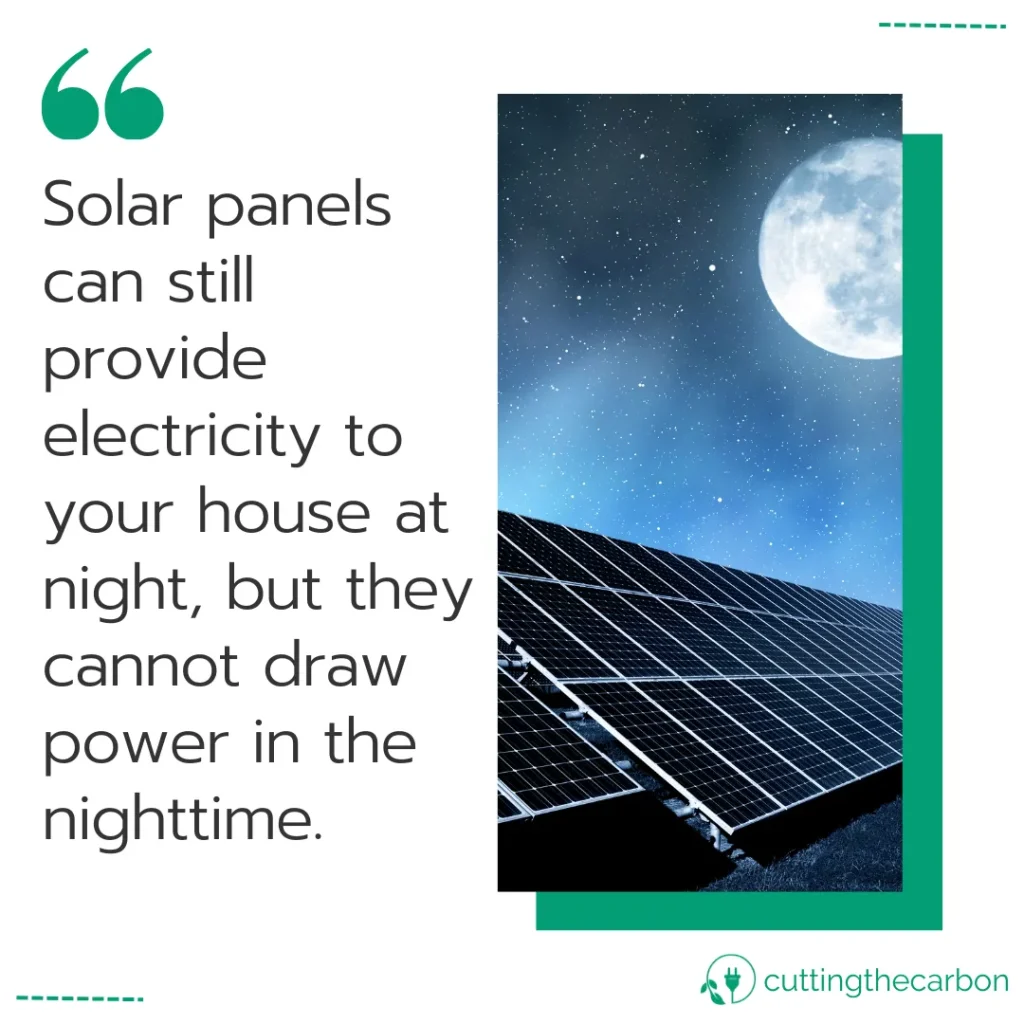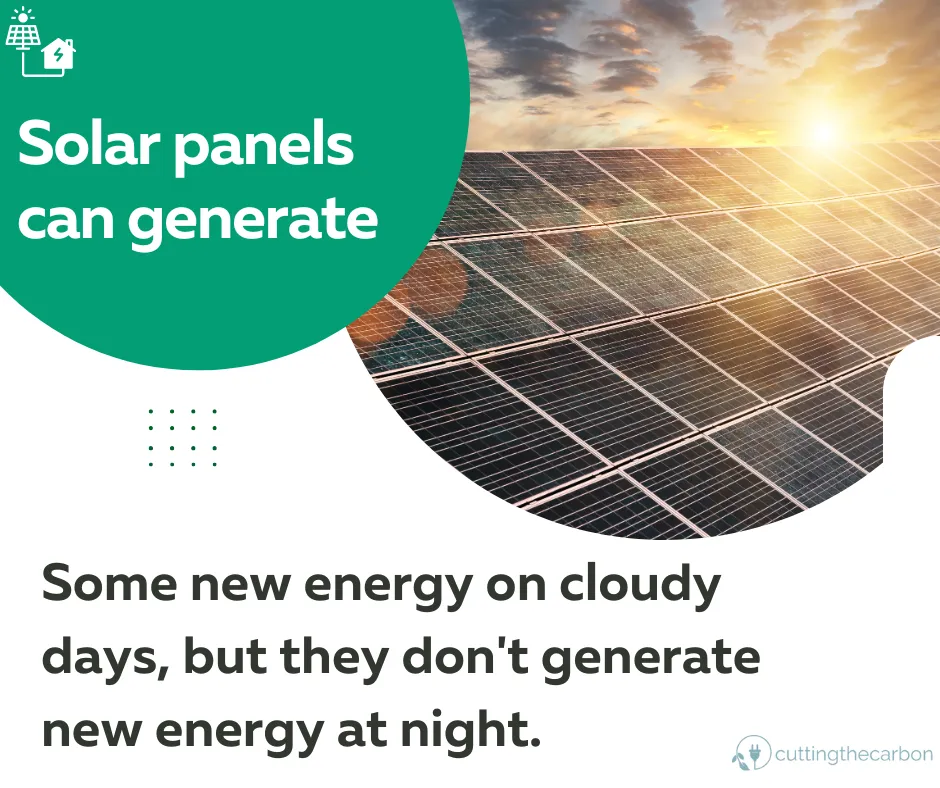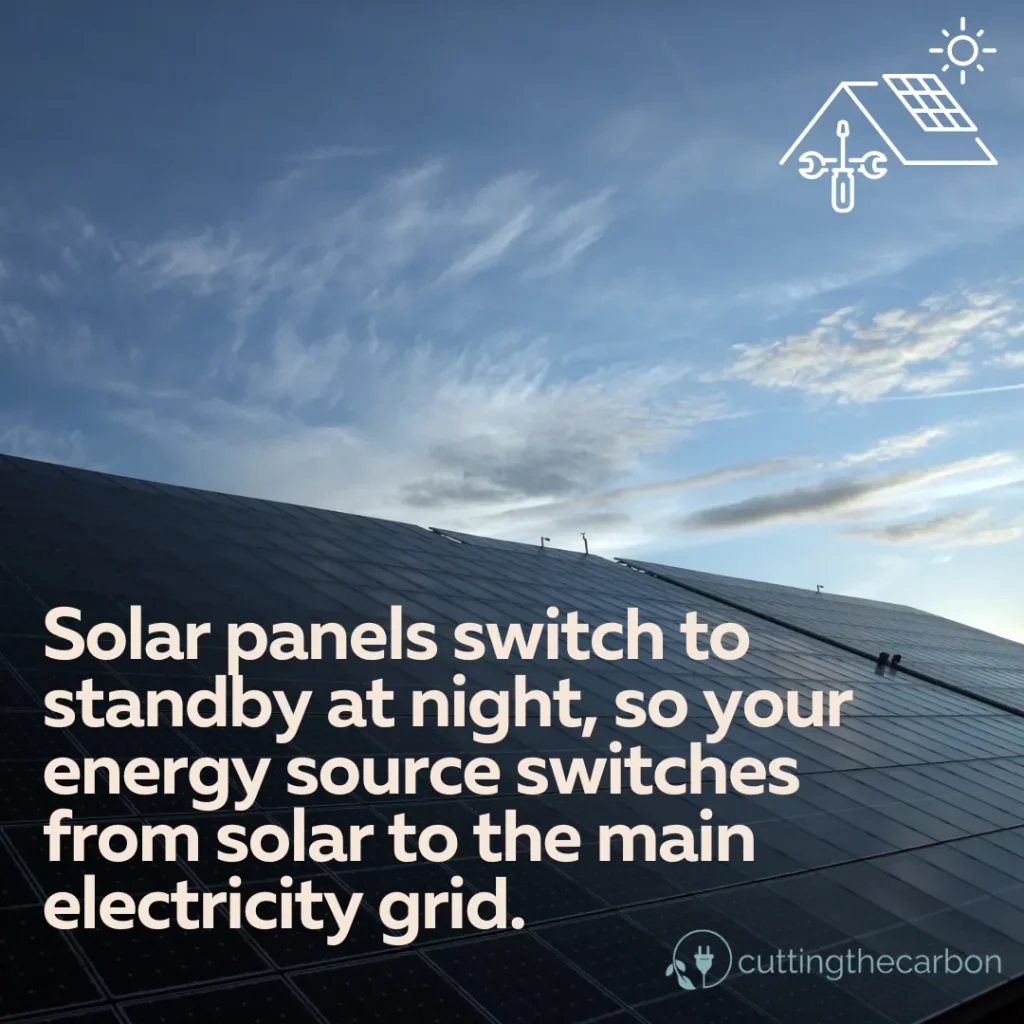Do solar panels need to be left on at night? It’s a question we’ve been asked quite frequently.
Figuring out the complexities of solar power can be perplexing, leaving many to ponder if they need to switch their panels on at night.
Understanding how these eco-friendly powerhouses work can seem daunting. But knowing their day and night functionality separates an average homeowner from a solar-savvy one.
You’re not alone if you’re unsure whether your panels should stay ‘on’ after sundown. Navigating the complexities of photovoltaic cells can be a challenge.
Quick Summary:
- They automatically stop producing energy when the sun goes down, so there’s no need to turn them off.
- Any excess energy generated during the day can be stored in batteries at night, but the panels remain inactive until the sun rises again.

The Intricacies of Solar Panels and Nighttime Functionality
What’s the deal with solar panels when night falls? In essence, while your home won’t be plunged into darkness after sunset if you’re utilising a solar panel system – various solutions ensure continuous power supply even when the sun isn’t shining.
Solar Panels: Day Vs Night Performance
Contrary to popular belief about how solar energy works – it’s not just for daylight hours. These systems perform best under direct sunlight, but they aren’t entirely useless once dusk settles in.
- Prolonged summer days or peak sunshine periods allow for excess energy production, which can be stored during non-productive times like nighttime or overcast conditions.
Limits of Photovoltaics During Dark Hours
Dependence on Sunlight
Photovoltaic (PV) cells, commonly known as solar panels, use sunlight to generate electricity. They convert photons from sunlight into electrical energy, which can be used to power homes, businesses, and other applications.
During the day, when sunlight is abundant, PV systems can be highly effective. However, their performance is significantly limited during dark hours, such as nighttime or during heavy cloud cover.
Energy Storage Challenges
One of the main challenges of using photovoltaics is the need for energy storage. Since solar panels cannot generate electricity at night, there must be a way to store the energy produced during the day for use during dark hours.
Battery storage systems have been developed to address this issue, but they can be expensive and have limitations in capacity and efficiency. The technology is improving but is still a significant barrier to continuous solar energy utilisation.
Impact on Grid Stability
The intermittent nature of solar energy can also have implications for the electrical grid’s stability. If a significant portion of a region’s energy comes from solar power, there may be substantial fluctuations in energy supply throughout the day.
This requires careful management and often supplementary energy sources to maintain a stable energy supply. Utilities must invest in grid infrastructure and management systems to handle these fluctuations, adding complexity and cost to the energy system.
Despite these challenges, there are ongoing efforts to overcome the limitations of photovoltaics during dark hours. Innovations in battery technology, such as developing more efficient and affordable storage solutions, are helping to make solar energy more viable around the clock.
Integrating solar power with renewable energy sources, like wind or hydroelectric power, can create a more balanced and resilient energy system.
In conclusion, while photovoltaics offer a promising and sustainable energy solution, their dependence on sunlight presents significant challenges during dark hours.
The industry continues to evolve, and with further technological advancements and strategic planning, the limitations of solar energy during nighttime may be mitigated or even overcome in the future.
Harnessing Solar Energy During Long Summer Days
Solar panels work their magic when the sun shines longer on those UK summer days. They convert more direct sunlight into electricity via photovoltaic cells.
The result? An overflow of energy production that outpaces immediate consumption needs. But this surplus doesn’t go to waste.
The Role of Solar Battery Storage
This is where your trusty solar battery storage steps up its game. These systems capture and store any excess power generated by your single panel or multiple-panel setup during daylight hours for later use when darkness falls.
Consider it a personal stash of sunshine you can tap into at night. This ensures continuous supply even after sunset when your panels stop producing electricity due to lack of light exposure – an efficient way to harness all that abundant sunshine on long summer days.
You might be wondering about options available for such batteries.
There are many choices in the market today, including popular ones like Tesla’s Powerwall, which integrates seamlessly with existing solar panel systems providing a reliable power source round-the-clock.
- Solar Panels: Daytime Warriors: The solar panels use long summer days, soaking up every bit possible from direct sunlight and converting it efficiently through photovoltaic cells into usable electric current. The more intense and prolonged the sunlight, the greater energy they produce.
- Battery Storage: Night-time: Come nighttime, though, panels enter sleep mode but fear not because stored energy ensures we never run short off-grid thanks largely to the part played by advanced battery storage systems.
- Making the Most Out Of Sunlight With Efficient Systems: All said and done, the key here lies in maximising the potential in terms of generation (thanks to extended periods of strong daylight) and subsequent smart storing using cutting-edge technologies so nothing goes to waste, paving the way towards sustainable living without compromising lifestyle comforts. And remember, there are always experts on hand to guide your journey should you need assistance navigating the
UK summer days are a solar panel’s best friend, turning abundant sunlight into electricity. Any surplus energy is stored in batteries for use when night falls. So, while your panels snooze at night, the stored sunshine keeps your home humming along nicely.
Net Metering – A Bridge Between Day and Night
You might be wondering how your solar panels work when the sun sets. The answer lies in a clever system known as net metering.
This method allows you to feed any surplus electricity your solar panel system generates back into the electric grid during peak daylight hours. Think of it like an energy savings account where you can deposit extra power for later use.
The Role of Net Metering in Solar Energy Storage
So, what’s happening behind this process? During periods when there is no direct sunlight – such as at night or overcast days – rather than being left without power, you can draw from this ‘energy bank’.
This ensures that even though your solar panels don’t produce electricity after sunset, they still provide indirect nighttime solutions through stored energy.
Besides providing continuous access to green energy around the clock, net metering also comes with financial perks (Ofgem). Many utility companies offer credits for homeowners who return excess renewable energies to the grid.
These rewards can then offset costs incurred during non-productive times. Learn more about saving money with renewable energies here.

Navigating Local Regulations Around Net Metering
While it sounds simple enough, availability and conditions surrounding net metering programmes, differ widely depending on local regulations and individual policies set out by utility providers (National Grid Connecting).
Therefore, understanding these specifics before installing a single panel or full-scale photovoltaic cell setup becomes paramount.
How Effective Are Single Panel Systems?
You might be wondering, how well do single panel systems perform? However, the effectiveness of single panel systems is not solely dependent on their quantity. Other elements like location, orientation, and shading issues can significantly impact your solar power production.
The geographical spot where you live determines the amount of direct sunlight hitting your solar panels. Homes closer to the equator generally enjoy more sunshine hours than those further north or south.
Also important is which way your solar panels are facing – in UK households, for example, roofs that face towards the south typically capture maximum sun exposure.
Shading from trees or buildings nearby can seriously hamper a panel’s output; even partial shade can have this effect. So ensuring there’s minimal obstruction to sunlight becomes crucial when aiming for peak performance.
Enhancing Efficiency with Solar Battery Banks
Beyond getting an optimal placement and reducing shade effects on your solar panel system, another strategy exists: teaming up with solar battery banks.
These storage devices collect excess energy during daylight hours’ high-production periods so it can be used later when light levels drop – such as at night or overcast days.
This essentially transforms single-panel setups into mini-power stations capable of providing electricity 24/7, regardless of weather conditions.
By integrating these two technologies – photovoltaic cells (the technical term for what makes up a solar panel) and battery storage – homeowners stand to greatly improve their green technology solution while lessening reliance on grid-supplied power.

Making Sense of Solar Cells and Their Nighttime Dormancy
Comprehending the activity of photovoltaic cells when there is no daylight is necessary to exploit the whole capability of your solar panel system. As we know, photovoltaic cells in these panels convert light into electricity. However, once direct sunlight disappears, they cease producing power.
This doesn’t mean that a house powered by solar energy plunges into darkness when night falls. With mechanisms like net metering and battery storage systems at play, homeowners can still tap into their stored reserves for power throughout the night.
Exploring Alternatives When Net Metering Isn’t Available
In certain regions or circumstances, net metering might not be feasible due to local regulations or grid limitations. In such cases, looking at other options available for utilising stored energy from those long summer days when your panels are dormant is crucial.
Suppose you’re unsure about alternatives in your area or need advice on using your stored energy during non-productive hours. In that case, our team can provide personalised guidance based on regional renewable energy practices.
The right solution ensures that even though solar panels don’t work at night, they continue providing indirect value through the effective usage of previously generated and efficiently stored power.
Practical Applications of Stored Solar Energy at Home
In the UK, many dwellings are making use of retained solar energy. One of its most popular applications is lighting. With an efficient solar battery storage system, homeowners can power their lights using this renewable source once darkness falls.
Beyond illumination, heating represents another practical application for stored solar energy. Central heating systems and water heaters, which typically consume significant amounts of electricity, can be powered by surplus solar power captured during daylight hours.
The Rise of EV Charging Stations Powered by Solar Energy
As more people embrace electric vehicles (EVs), charging these cars with green energy has become increasingly relevant. Having your own personal EV charging station fueled by your home’s solar panel system not only cuts running costs but also helps lower overall emissions – a win-win situation.
Sun-Powered Household Appliances: A New Norm?
Last but certainly not least on our list are household appliances like refrigerators or washing machines, which, too, have begun benefiting from stored solar power. The prospect of daily chores without worrying about hefty electricity bills at month-end sounds appealing.
This shift towards harnessing clean, renewable sources within domestic settings marks just one step in our collective journey towards achieving sustainability goals as part of future green living trends.
The Future of Solar Energy Storage in the UK
Envision a world where your abode is powered by the sun, stockpiled adeptly to be tapped whenever you wish. That’s the vision of green technology solutions in the UK.
Solar panels are already transforming how we generate electricity. But what about when there’s no direct sunlight? How do we keep our homes running on those long winter nights or cloudy days?
This is where emerging technologies come into play – they’re shaping up to be game-changers in solar energy storage.
Governing Policies and Renewable Energies
In recent years, government incentives have played a pivotal role in promoting renewable energies like solar power across the country. One such initiative that stands out is the Smart Export Guarantee (SEG) scheme.
Under this policy, homeowners who produce surplus electricity from their photovoltaic cells can export it back to the electric grid and earn money. It’s an effective way to save on your energy bills and contribute towards reducing carbon emissions nationwide.
Potential Challenges in Transitioning to Green Living
However, transitioning to green living isn’t without its hurdles – high initial costs being one of them.
- Budget Constraints: These cutting-edge advancements might seem daunting due to the upfront expenses of setting up efficient battery storage systems alongside single or multiple-panel setups at home.
- Limited Space & Sunlight Exposure: Besides financial considerations, practical issues like limited roof space and suboptimal orientation could pose challenges.
Despite these potential roadblocks, making sustainable choices has never been more accessible than now, thanks largely to expert guidance available today helping navigate complexities associated with transitioning to an eco-friendly lifestyle.
FAQs concerning Do Solar Panels Need to Be Left on at Night
Should I turn off solar panels at night?
No, switching off your solar panels at night is unnecessary. They automatically stop producing electricity when the sun sets.
When should I turn my solar panels off?
Solar panels don’t require manual turning on or off. However, you might need to shut them down for maintenance or during extreme weather conditions.
What do you do at night if you have solar panels?
If your system includes battery storage or is connected to the grid via net metering, it will use stored energy or draw from the grid once the sun goes down.
Do solar panels use electricity at night?
No, they don’t consume power. Instead, they supply stored energy back into your home or go dormant until daylight returns.
Alternative Solutions and Future Prospects
Despite these challenges, there are ongoing efforts to overcome the limitations of photovoltaics during dark hours. Innovations in battery technology, such as developing more efficient and affordable storage solutions, are helping to make solar energy more viable around the clock.
Integrating solar power with renewable energy sources, like wind or hydroelectric power, can create a more balanced and resilient energy system.
Conclusion
While photovoltaics offer a promising and sustainable energy solution, their dependence on sunlight presents significant challenges during dark hours.
The industry continues to evolve, and with further technological advancements and strategic planning, the limitations of solar energy during nighttime may be mitigated or even overcome.
We’ve delved into their functionality, from harnessing sunlight during long summer days to their dormancy at night.
The answer is clear: Solar panels don’t need to be left on at night. They rest while your stored energy takes over.
Solar battery storage systems like Tesla’s Powerwall have emerged as game-changers, storing surplus daytime energy when darkness falls.
Net metering too plays a pivotal role in bridging day and night, depositing excess electricity into the grid for later use.
Single panel or multiple setups? The choice hinges on location and orientation, but coupling with solar battery banks can still enhance efficiency further.
In our homes, stored solar energy lights up rooms heats spaces, and powers appliances – even charges electric vehicles!
A future where more UK homeowners embrace this sustainable lifestyle beckons, government incentives are increasing, and emerging technologies promise exciting developments in renewable energies.

